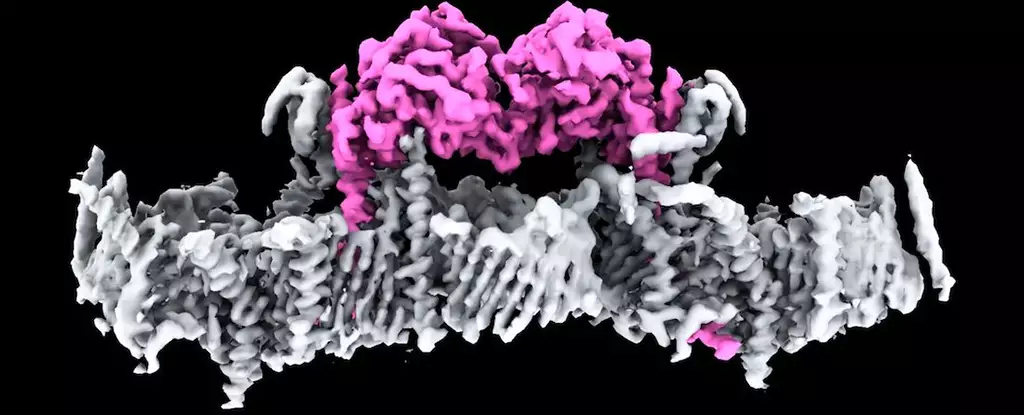For years, the scientific community has battled with the enigma surrounding Parkinson’s disease, a condition that touches millions worldwide through its debilitating effects. Recently, groundbreaking work by researchers from the Walter and Eliza Hall Institute of Medical Research (WEHI) in Australia has uncovered the first detailed view of a mitochondrial protein known as PTEN-induced putative kinase 1 (PINK1), unveiling crucial insights into its connection to the progression of Parkinson’s disease. Previous research had established a strong correlation between mutations in the PINK1 gene and early-onset Parkinson’s; however, the intricacies of how these mutations influence the disease remained largely unknown.
The startling revelations emerging from WEHI illustrate not just PINK1’s structure but also its interaction with mitochondria—the energy-producing powerhouses of our cells. This milestone is not merely a scientific curiosity; it represents a potential turning point in our understanding and management of this complex neurodegenerative disease.
Importance of Mitochondrial Health
Mitochondria are far more than mere energy sources; they are critical for the overall health of our cells. In robust biological systems, PINK1 functions as an internal maintenance worker that ensures mitochondrial integrity. When mitochondria are operating as intended, PINK1 integrates seamlessly into their structural framework, performing its duties without disruption. However, when these organelles falter, PINK1 exhibits a remarkable response. Instead of maintaining a silent presence, it temporarily halts its movement, alerting the cell that repair or elimination is necessary.
This process involves a cascade of signaling events, particularly the tagging of damaged mitochondria through a molecule known as ubiquitin. Such signaling is vital for brain health, where energy demand is high. The failure to clear dysfunctional mitochondria may lead to a toxic buildup that wreaks havoc, potentially triggering or exacerbating neurodegenerative diseases like Parkinson’s.
Advanced Techniques Illuminate New Pathways
Utilizing cutting-edge techniques such as cryo-electron microscopy and mass spectrometry, the researchers at WEHI meticulously analyzed PINK1 and its mitochondrial interactions. Their work revealed a specific protein complex known as TOM-VDAC that serves as the docking site for PINK1 on damaged mitochondria. This discovery is groundbreaking, as it provides a clear picture of how PINK1 attaches to mitochondria and how mutations in the gene can interfere with that attachment.
Sylvie Callegari, a biochemist on the team, emphasizes the significance of this insight: “For the first time, we’ve visualized human PINK1 attached to damaged mitochondria.” Such detailed observations not only illuminate the protein’s function but also highlight the implications of genetic mutations found in individuals with Parkinson’s disease.
A Step Toward Revolutionary Treatments
As the WEHI team continues to delve into the mechanisms governing PINK1, there lies the tantalizing possibility of developing targeted therapies that can rectify the protein’s functionality and potentially mitigate the risk of developing Parkinson’s or slow its progression. The implications are profound. Imagine being able to intervene at a cellular level to restore the balance necessary for healthy brain function—a prospect that appears closer than ever as this research unfolds.
David Komander, a prominent medical biologist at WEHI, has underscored the transformative potential of these findings: “Our structure reveals many new ways to change PINK1, essentially switching it on, which will be life-changing for people with Parkinson’s.” This perspective hints at a horizon filled with hope for patients grappling with the realities of Parkinson’s—a disease that has long been characterized by limited understanding and few effective treatments.
Complexities of Parkinson’s Disease
Despite the excitement surrounding these breakthroughs, it’s essential to recognize that Parkinson’s is a multifaceted disease influenced by various genetic, environmental, and lifestyle factors. While elucidating the role of PINK1 is significant, it may only scratch the surface of understanding numerous underlying causes that come into play with this complex condition. Each new revelation about PINK1 and its mechanisms provides a vital piece in the intricate puzzle of Parkinson’s disease, steadily bringing researchers closer to a comprehensive understanding.
As research progresses, the spotlight will undoubtedly continue to shine on PINK1, and the scientific community remains hopeful that the path laid out by this pioneering work will lead to innovative strategies for prevention and treatment of one of humanity’s most challenging neurological disorders. The journey towards unlocking the mysteries of Parkinson’s is fraught with challenges, but with each discovery, we move one step further toward a future filled with possibility and renewed optimism.


Leave a Reply